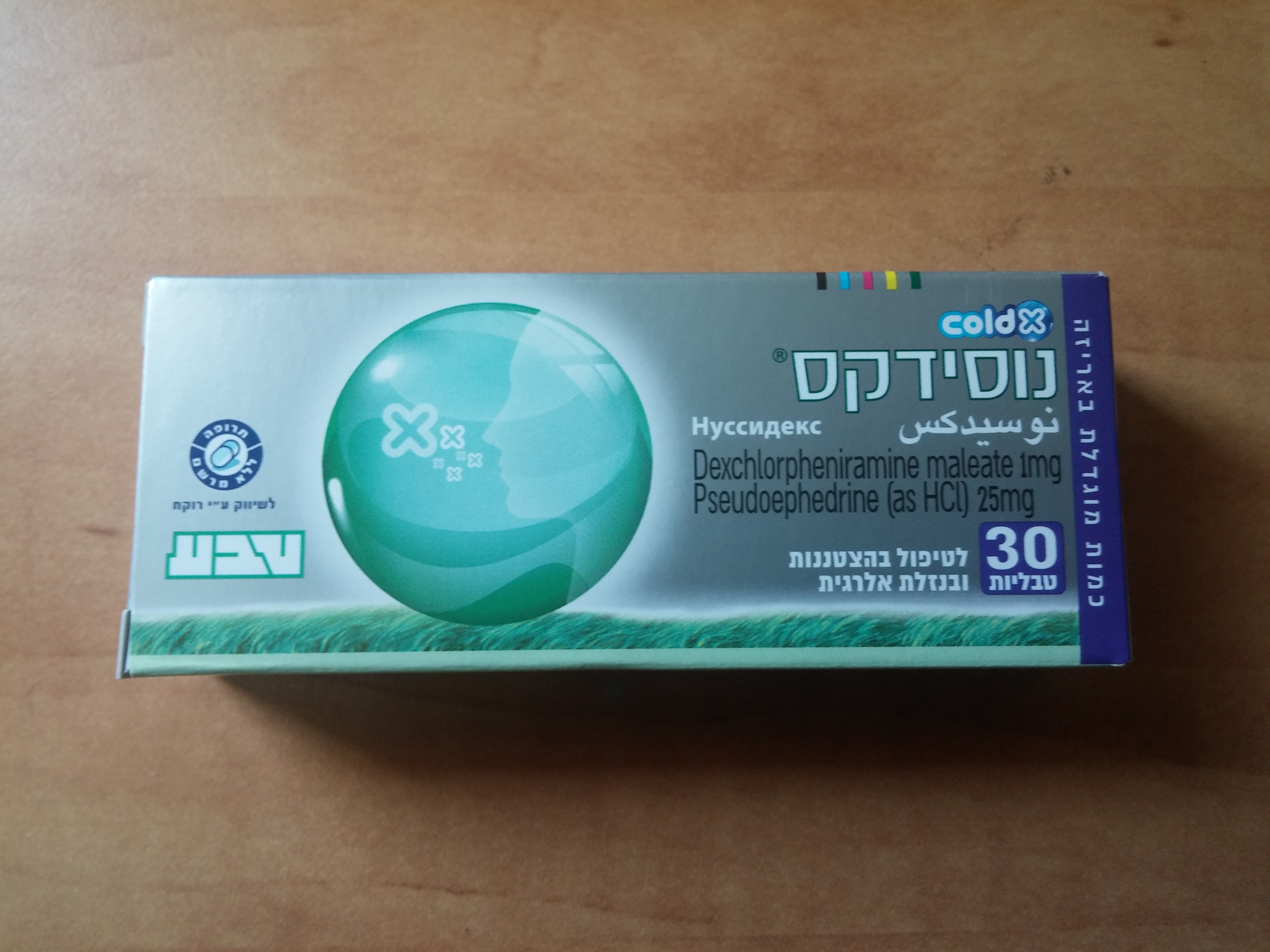Quest for the right Drug

נוסידקס NUSSIDEX (DEXCHLORPHENIRAMINE MALEATE, PSEUDOEPHEDRINE AS HYDROCHLORIDE)
תרופה במרשם
תרופה בסל
נרקוטיקה
ציטוטוקסיקה
צורת מתן:
פומי : PER OS
צורת מינון:
טבליה : TABLETS
עלון לרופא
מינוניםPosology התוויות
Indications תופעות לוואי
Adverse reactions התוויות נגד
Contraindications אינטראקציות
Interactions מינון יתר
Overdose הריון/הנקה
Pregnancy & Lactation אוכלוסיות מיוחדות
Special populations תכונות פרמקולוגיות
Pharmacological properties מידע רוקחי
Pharmaceutical particulars אזהרת שימוש
Special Warning עלון לרופא
Physicians Leaflet
Pregnancy & Lactation : הריון/הנקה
4.6 Fertility, Pregnancy and Lactation Dexchlorpheniramine Pregnancy Safety during pregnancy has not been established. Dexchlorpheniramine maleate should be used during the first two trimesters of pregnancy only if clearly needed. Dexchlorpheniramine maleate should not be used in the third trimester of pregnancy because newborn and premature infants may have severe reactions to antihistamines. Dexchlorpheniramine maleate has been taken by a large number of pregnant women and women of childbearing age without any proven increase in the frequency of malformations or other direct or indirect harmful effects of on the foetus having been observed. Breastfeeding Dexchlorpheniramine maleate is excreted in breast milk. Therefore, caution should be exercised when administered to nursing mothers. Pseudoephedrine There are no adequate and well-controlled clinical studies in pregnant or breast-feeding women for the combination of pseudoephedrine. This product should not be used during pregnancy or lactation unless the potential benefit of treatment to the mother outweighs the possible risks to the developing foetus or breastfeeding infant. Pregnancy The safety of pseudoephedrine in pregnancy has not been established. A large amount of data on pregnant women indicate neither malformative, nor feto/neonatal toxicity. Breast-feeding Pseudoephedrine is excreted in breast milk in small amounts but the effect of this on breast-fed infants is not known. Ithas been estimated that approximately 0.4 to 0.7% of a single 60 mg dose of pseudoephedrine ingested by a nursingmother will be excreted in the breast milk over 24 hours. Data from a study of lactating mothers taking 60 mg pseudoephedrine every 6 hours suggests that from 2.2 to 6.7% of the maximum daily dose (240 mg) may be available tothe infant from a breastfeeding mother. Fertility No studies have been conducted in animals to determine whether pseudoephedrine has the potential to impair fertility. There is no information of the effect of this product on fertility.

שימוש לפי פנקס קופ''ח כללית 1994
Symptomatic treatment of common cold, allergic & vasomotor rhinits, hay fever
תאריך הכללה מקורי בסל
01/01/1995
הגבלות
תרופה שאושרה לשימוש כללי בקופ'ח
מידע נוסף
עלון מידע לצרכן
31.10.16 - עלון לצרכן 10.05.23 - עלון לצרכן עברית 21.08.23 - עלון לצרכן אנגלית 21.08.23 - עלון לצרכן עברית 21.08.23 - עלון לצרכן ערבית 29.01.24 - עלון לצרכן עברית 12.02.24 - עלון לצרכן אנגלית 12.02.24 - עלון לצרכן עברית 12.02.24 - עלון לצרכן ערבית 19.03.24 - עלון לצרכן עברית 13.05.24 - עלון לצרכן אנגלית 13.05.24 - עלון לצרכן עברית 13.05.24 - עלון לצרכן ערבית 31.07.24 - עלון לצרכן עברית 20.09.24 - עלון לצרכן אנגלית 20.09.24 - עלון לצרכן ערבית 26.09.24 - עלון לצרכן עברית 10.05.23 - החמרה לעלון 28.12.23 - החמרה לעלון 29.01.24 - החמרה לעלון 19.03.24 - החמרה לעלון 31.07.24 - החמרה לעלוןלתרופה במאגר משרד הבריאות
נוסידקס